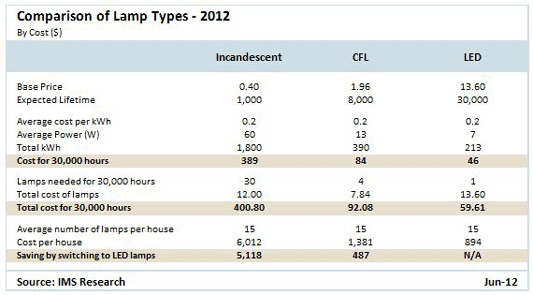- News
4 July 2012
LED lamps to provide savings of $100bn over 5 years
The widespread adoption of retrofit LED lamps will create global energy savings worth $100bn over the next five years, according to the report ‘Opportunities for Power Components in LED Lighting’ from IMS Research. Although the use of LED lamps for general lighting is not currently widespread, the rapid uptake of retrofit LED lamps will result in a potential market of more than 4 billion units by 2016, reckons the market research firm. While adoption is currently driven largely by legislation, it is forecast to accelerate as consumers become more aware of the long-term savings that are attainable compared with competing lighting technologies.

“The environmental impact that global adoption of LED lighting will have is colossal,” says report co-author and senior market analyst Ryan Sanderson. “Lighting accounts for approximately 19% of the world’s energy use at present,” he adds. “IMS predicts that in 2016 around 15% of all lighting will be accounted for by LED, which would reduce global energy consumption of lighting by around 20%.”
Retrofit LED lamps use a fraction of the power of incandescent lamps to provide a similar luminance. The report forecasts that in 2012 alone the use of retrofit LED lamps in place of incandescent lamps will result in energy savings of more than 30 gigawatt hours. By 2016, with widespread adoption of retrofit LED lamps, these savings are forecast to reach more than 300GWe. It is calculated that the five-year cumulative total will be more than 800GWe, worth more than $100bn.
“To generate the 800GWe of energy in 2016 years you would need to run more than 50 nuclear power stations at full capacity,” says report co-author and market analyst Jonathon Eykyn. “At a time when the world is struggling to balance the use of more sustainable power sources with the need to provide access to low-cost power sources to support economic growth, LED lighting could be a large part of the solution,” he adds.
The benefits of using LED lamps to the general consumer are reductions in average household energy bills, says IMS. To buy and power a lamp for four hours a day for a year, it costs the average household $20 for an incandescent lamp currently, but it would cost $16 for an LED lamp (a saving of 20%). However, compact fluorescent lamps (CFLs) compete much better on efficiency with LED lamps and are becoming a popular lower-cost alternative to incandescent lighting. Despite a CFL lamp currently costing on average just $6 to buy and power for a year (making it the most economical choice currently), LED lamps use, on average, half the power of a CFL lamp. Therefore, the advantages of LED lamps become apparent in the longer term, helped by the dislike of CFLs due to their poor light quality, says IMS.
An LED lamp has an average life expectancy of 30,000 hours ( 30 times longer than an incandescent lamp and 3.75 times longer than a CFL lamp). If the savings were calculated over the lifetime of the lamp, LED lamps become the cheapest solution, notes IMS. For example, a typical house with 15 lamps would save more than $5100 over 20 years by switching from incandescent to retrofit LED lamps. A house with CFLs installed would save nearly $500 over 20 years by moving to retrofit LED lamps. These savings will increase as the cost of LED lamps continues to fall significantly, especially over the next five years, forecasts the market research firm.
